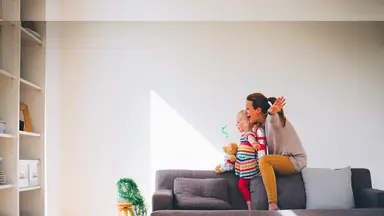How to define the need for Passive House ventilation

- Home
- Insights
- Ventilation insights
- How to define the need for Passive House ventilation
A residential ventilation system constantly monitors the air humidity in the home and adjusts the ventilation automatically until the air quality is optimal. Meanwhile, up to 96% of the heat from the exhaust air in the kitchen, living room and bathroom is reused to heat up the supply air, so a pleasant temperature is achieved using the least possible energy consumption. This provides both air renewal and a healthy indoor climate. This article explains on broad terms how we interpret the Passive House standard in relation to identifying the right system for your project.
A Passive House requires the use of ventilation systems fitted with heat recovery, otherwise far more energy will be wasted per year than a Passive House actually uses for heat. At the same rate of air exchange, a ventilation unit without heat recovery loses around 24kWh/(m²yr) – the maximum space heating demand is just 15kWh/(m²yr).
Therefore, a Passive House requires ventilation systems with a heat recovery efficiency of at least 75% and power consumption should not exceed 0.45Wh/m³ of the transport air volume. Moreover, the acoustic load of the ventilation systems should not exceed 25dB in living rooms and 35dB in the ventilation system room. This requires careful planning of ductwork and installation of silencers.
Size and flow rates
The manual for the Ventilation Final Protocol Worksheet, which is supplied with the Passive House Planning Package (PHPP) describes how much air to supply in a Passivhaus. The principle is that when the ventilation system is running, supply air and extract air must be equal, i.e. in balance.
Supply air is set at 30m3/h per person calculated using the actual number of people expected to live in the house, instead of the default figure calculated by PHPP at 35m2/person. For under-occupied houses (>40m2 per person) the backstop rate is 0.3 ACH (air changes per hour). This gives the standard air flow rate, which is usually set as the medium fan speed. Extract rates are normally based on wet rooms: 60m3/h for kitchens, 40m3/h for bathrooms/utility rooms and 20m3/h for WC's.
The total extract rate is normally higher than the supply rate. This is countered by running both fans at the higher rate when cooking or bathing requires extract. The design ‘boost’ rate is either the ‘standard’ rate + 30% or the total extract rate, whichever is larger.
The PHPP calculations of the nominal rate are different. PHPP first sets the maximum flow as the larger of the supply and extract rates, as calculated above, and then sets the standard rate at 77% of this figure. This means that for densely occupied houses, the per-person rate is lower than 30m3/h per person and for houses with many bathrooms the per-person rate comes out higher.
It is recommendable to follow the 30m3/h person standard rate and adjust extract rates up or down to reach a boost of +30-40%, provided that local legislations is maintained.
In terms of specifying the air flow to each room, the basic rule is to secure a bedroom supply of at least 15m3/h/person and then reserving the rest for living spaces.
Depending on the floorplan, dining rooms often do not need their own supply because they can rely on air passing through to the kitchen. Extract rates are set according to room type but have to be reduced proportionally from the boost rate to the standard rate to ensure that the supply and extract rates are in balance.
At Dantherm, we consider the Passivhaus level to be adequate because residential ventilation units with heat recovery provide a significantly higher fresh air rate in bedrooms and living rooms. The Passivhaus level also reduces the risk of drying of internal air during winter time. In addition, the Passivhaus design enables you to use a ‘low’ fan speed, which is normally 30% lower than the standard rate. This is ideal when the house is unoccupied.
The highest requirement applies
In general, the supply of air and exhaust needs to be balanced. Therefore, the highest figure determines the required ventilation system capacity.
A ventilation system has a maximum performance. It is crucial that you choose a system that is suitable for the task. If you choose a system that can only supply the minimum requirement for air supply/exhaust at maximum performance, you risk having an underpowered system that uses an inexpedient amount of energy to do its job and which is also noisier than it needs to be.
Noise requirements for residential ventilation
Passivhaus recommends noise from technical installations, including ventilation systems, to be lower than 25dB in living rooms and 35dB in the ventilation system room.
Related products
Featured insights

Automatically maintain your ideal living conditions

Find out how to improve the air quality in your house

Thermal efficiency, SFP, fire safety and heat exchanger are key to your choice
Need help with choosing the right solution? Our team of over 100 climate control experts can assist.
You can also reach out or join the discussion on our Social Media. Check out our LinkedIn page.







